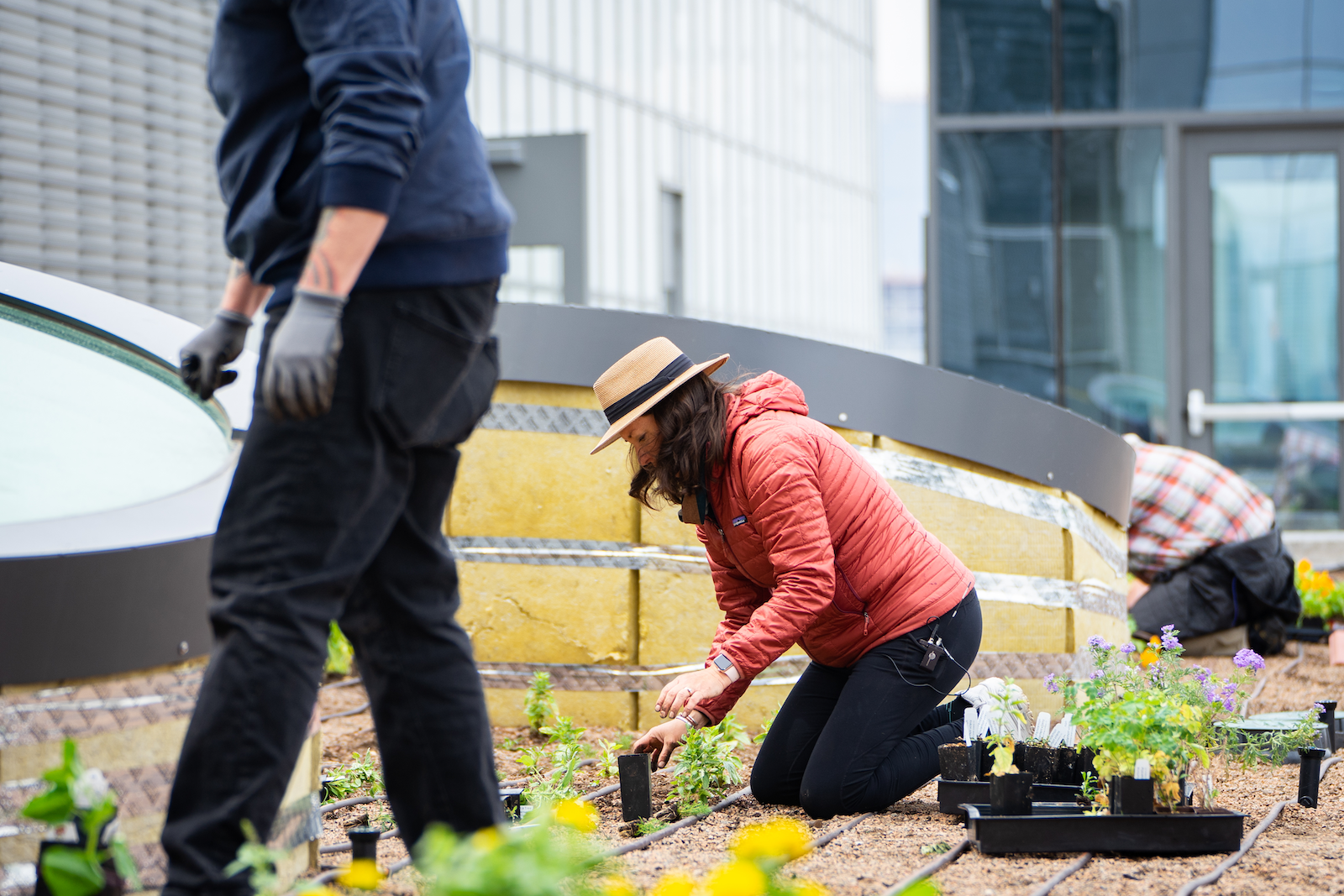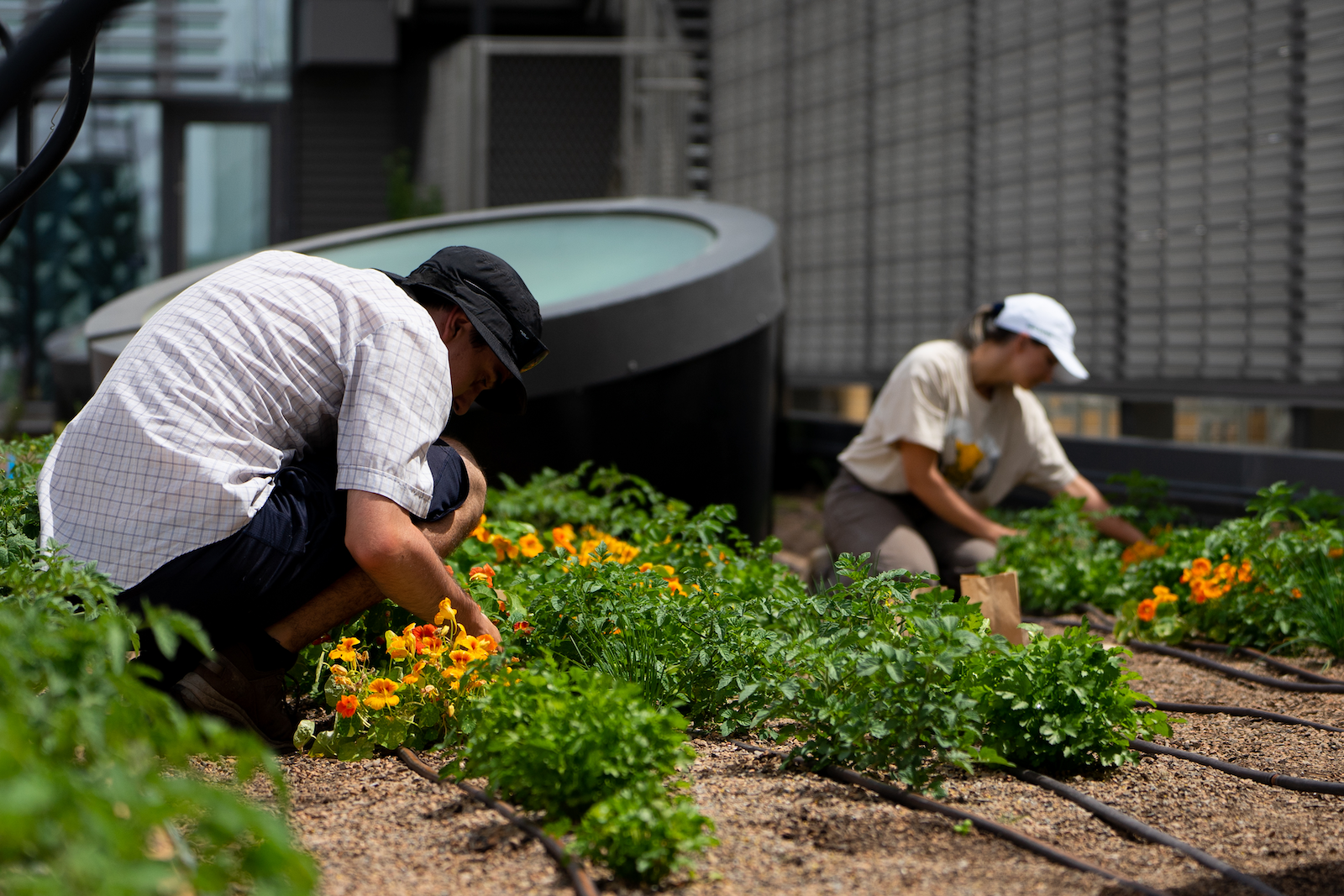Research green roof thriving at CSU Spur campus
story by Anthony Lane published August 30, 2022More than a hundred pounds of tomatoes. Forty-eight pounds of cucumbers. Nearly 20 pounds of basil, dill, cilantro, and other herbs.
In all, the research green roof at the CSU System Spur campus has now produced 204.5 pounds of produce in its initial growing season at the recently opened Terra building.
This harvest has already bolstered deliveries for local families participating in a food access program administered by The GrowHaus. For Jennifer Bousselot, an assistant professor of horticulture at CSU and lead designer of the research green roof, it is also providing an exciting glimpse at how urban rooftops might be transformed in coming years into productive gardens that can help feed, inspire, and inform surrounding communities.
“This is the largest publicly accessible green roof research space that we know about,” Bousselot said. “To be able to do this research in Colorado’s biggest city is incredible.”
The green roof, open to Spur visitors during the campus’s regular operating hours, currently has four sections, including a 576-square-foot food production area that contains a “salsa garden” replete with tomatoes, peppers, cilantro, and chives, as well as nasturtiums, which add their edible, orangey-red petals to the mix.
Three other sections are exploring different types of plants and how they respond to the weather extremes of a Denver rooftop.
- A “Pollinator Garden” aims to optimize the growth of beardtongues, red-birds-in-a-tree, columbines, and other flowering plants that can support the overall health of the urban ecosystem;
- A “Medicinal Plant” section is seeking insight on how lemongrass, mint, and other species react to the intense conditions found on urban rooftops;
- And a “Sown Meadow” comprised of coreopsis, California poppies, and other species is providing multiple plots to examine combinations that maximize growth and pollinator habitat.
Students, including K-12 school groups visiting Spur, have been involved from the beginning in research and upkeep of the green roof. On an ongoing basis, four CSU students completing internships with Bousselot have taken on much of the work maintaining the space, and the green roof is the research focus for two of Bousselot’s graduate students from the department of horticulture and landscape architecture.
Leah McGill, a CSU senior majoring in agricultural biology, talked about her summer internship experience, from planting and tending vegetables and flowers, to tracking their growth and even working on the irrigation system.
“I learned so much about different careers, and even about the interconnections involving construction and landscaping and education,” McGill said. And she appreciated the team’s partnership with GrowHaus and the opportunity to interact with families. “I wasn’t expecting that community element.”

Jennifer Bousselot helps plant the green roof. Photo: Kevin Samuelson / CSU System
While the scale of a rooftop garden is tiny compared to that of commercial farms, Bousselot explains how producing fresh produce for nearby communities is just one of many benefits associated with transforming plentiful – and generally barren – urban rooftops into thriving gardens. In addition to investigating how best to grow plants in the rooftop environment, her research team is exploring the extent to which green roofs can help reduce stormwater runoff and provide other benefits.
A second research green roof, which will be installed on the Spur campus’s nearly complete Hydro building, will take urban agriculture in a different direction by exploring its complementarity with solar panels, an area known as rooftop agrivoltaics. The panels, positioned alone on a rooftop, are great for converting solar radiation into electricity, and yet temperatures, particularly in summer, can quickly climb above the optimal temperature range, in the mid 70s Fahrenheit, at which the panels work most efficiently. Pairing the panels with a green roof is a way to cut those temperatures, and the extra shade also benefits certain plant species that may not need or benefit from constant direct sunlight.
Reducing the urban heat island effect and decreasing greenhouse gas emissions are two of the primary goals of Denver’s Green Buildings Ordinance, which took effect in 2018 and requires developers and property owners who are constructing or modifying buildings over a certain size to pick from a menu of options aimed at limiting heating and increasing overall green space. Bousselot, who serves on the board of the North American green roof industry association, Green Roofs for Healthy Cities, served as a technical adviser in crafting the Denver ordinance, and she sees the ways the research at Spur and at other sites will help lead to the installation of green roofs that are both efficient and elegant.
This elegance is apparent to those visiting the Terra building’s research green roof, which is accessible from the fourth floor. The garden is compact and organized, and in late summer it is resplendent with myriad flowers, along with plump tomatoes, delicate fairy tale eggplants, and hearty jalapeños.
Exposing students and community members to research and activities involving food, water, and health is central to the mission of the Spur campus, the construction of which was funded in 2015 with $200 million from the state legislature. The Terra building, which opened in June and includes the research green roof, is the second of three CSU buildings that will be part of the National Western Center, a redevelopment of the historic grounds of the National Western Stock Show in north Denver. The third building, Hydro, is scheduled to open in January.
Jocelyn Hittle, the CSU System’s associate vice chancellor for the Spur campus and special projects, has been closely involved in development of the campus from the beginning, and she has been thrilled to see the way school groups, community members, and other visitors to the green roof and other Spur research spaces have reacted upon seeing science being done right in front of them.
“At Terra, for instance, the programs are focused on innovations in agriculture, and on letting people see the creative ways that researchers are working to make food production more sustainable,” Hittle said. “It’s about providing a space in which visitors can connect with the scientists and businesses involved in each step in the food system.”

Planting the green roof at CSU Spur Terra. Photo: Kevin Samuelson / CSU System
With construction of Spur’s three buildings nearing completion, the focus is now shifting toward the ways the campus will offer new insights into scientific research while helping visitors understand how they might become involved in addressing societal challenges.
Jim Bradeen, Colorado State University’s associate vice president for CSU Spur strategy, oversees the campus’s overall research enterprise, and he speaks excitedly about the dozens of programs that are underway at Spur or are in the works.
“The green roof and other activities at Spur are really creating a new model for education, outreach, and engagement,” Bradeen said. “I’m looking forward to seeing what happens as we bring more people into this critical work.”
About CSU Spur
CSU Spur is a new, free educational year-round public life-long learning destination in Denver focused on engaging K-12 students, families, and visitors around food, water, and health. CSU Spur showcases the work of the CSU System campuses: CSU, CSU Pueblo, and CSU Global, and offers degree programs that originate from the campus offerings. Spur is built upon the land-grant mission of access to education and the belief that students can be anything they want to be. To inspire learners of all ages to engage in important world issues, CSU Spur brings together scientists to collaborate, puts science on-display, and showcases career paths. The CSU Spur campus provides immersive learning experiences and cutting-edge research across three buildings: Vida, Terra, and Hydro. Learn more at CSUSpur.org.